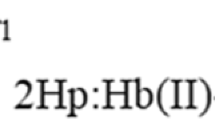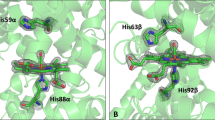Abstract
The synthesis of haemoglobin A (HbA) is exquisitely coordinated during erythrocyte development to prevent damaging effects from individual α- and β-subunits1,2. The α-haemoglobin-stabilizing protein (AHSP) binds α-haemoglobin (αHb), inhibits the ability of αHb to generate reactive oxygen species and prevents its precipitation on exposure to oxidant stress3,4,5. The structure of AHSP bound to ferrous αHb is thought to represent a transitional complex through which αHb is converted to a non-reactive, hexacoordinate ferric form5. Here we report the crystal structure of this ferric αHb–AHSP complex at 2.4 Å resolution. Our findings reveal a striking bis-histidyl configuration in which both the proximal and the distal histidines coordinate the haem iron atom. To attain this unusual conformation, segments of αHb undergo drastic structural rearrangements, including the repositioning of several α-helices. Moreover, conversion to the ferric bis-histidine configuration strongly and specifically inhibits redox chemistry catalysis and haem loss from αHb. The observed structural changes, which impair the chemical reactivity of haem iron, explain how AHSP stabilizes αHb and prevents its damaging effects in cells.
This is a preview of subscription content, access via your institution
Access options
Subscribe to this journal
Receive 51 print issues and online access
$199.00 per year
only $3.90 per issue
Buy this article
- Purchase on Springer Link
- Instant access to full article PDF
Prices may be subject to local taxes which are calculated during checkout




Similar content being viewed by others
References
Bunn, H. F. Subunit assembly of hemoglobin: an important determinant of hematologic phenotype. Blood 69, 1–6 (1987)
Baglioni, C. Chromosomal and cytoplasmic regulation of haemoglobin synthesis. Bibl. Haematol. 29, 1056–1063 (1966)
Kihm, A. J. et al. An abundant erythroid protein that stabilizes free α-haemoglobin. Nature 417, 758–763 (2002)
Kong, Y. et al. Loss of α-hemoglobin-stabilizing protein impairs erythropoiesis and exacerbates β-thalassemia. J. Clin. Invest. 114, 1457–1466 (2004)
Feng, L. et al. Molecular mechanism of AHSP-mediated stabilization of α-hemoglobin. Cell 119, 629–640 (2004)
Scott, M. D. et al. Effect of excess alpha-hemoglobin chains on cellular and membrane oxidation in model beta-thalassemic erythrocytes. J. Clin. Invest. 91, 1706–1712 (1993)
Nathan, D. G. & Gunn, R. B. Thalassemia: the consequences of unbalanced hemoglobin synthesis. Am. J. Med. 41, 815–830 (1966)
Rachmilewitz, E. A. & Schrier, S. L. in Disorders of Hemoglobin (eds Steinberg, M. H., Forget, B. G., Higgs, D. R. & Nagel, R. L.) 233–251 (Cambridge Univ. Press, Cambridge, 2001)
Gell, D., Kong, Y., Eaton, S. A., Weiss, M. J. & Mackay, J. P. Biophysical characterization of the α-globin binding protein α-hemoglobin stabilizing protein. J. Biol. Chem. 277, 40602–40609 (2002)
Santiveri, C. M. et al. NMR structure of the α-hemoglobin chaperone AHSP: Insights into conformational heterogeneity and binding. J. Biol. Chem. 279, 34963–34970 (2004)
Dickerson, R. E. & Geis, I. Hemoglobin: Structure, Function, Evolution and Pathology (Benjamin/Cummings, Menlo Park, 1983)
Nagababu, E. & Rifkind, J. M. Heme degradation by reactive oxygen species. Antioxid. Redox Signal. 6, 967–978 (2004)
Rifkind, J. M., Ramasamy, S., Manoharan, P. T., Nagababu, E. & Mohanty, J. G. Redox reactions of hemoglobin. Antioxid. Redox. Signal. 6, 657–666 (2004)
Alayash, A. I., Ryan, B. A., Eich, R. F., Olson, J. S. & Cashon, R. E. Reactions of sperm whale myoglobin with hydrogen peroxide. Effects of distal pocket mutations on the formation and stability of the ferryl intermediate. J. Biol. Chem. 274, 2029–2037 (1999)
Nagababu, E. & Rifkind, J. M. Reaction of hydrogen peroxide with ferrylhemoglobin: superoxide production and heme degradation. Biochemistry 39, 12503–12511 (2000)
Reeder, B. J., Svistunenko, D. A., Sharpe, M. A. & Wilson, M. T. Characteristics and mechanism of formation of peroxide-induced heme to protein cross-linking in myoglobin. Biochemistry 41, 367–375 (2002)
Berzofsky, J. A., Peisach, J. & Horecker, B. L. Sulfheme proteins. IV. The stoichiometry of sulfur incorporation and the isolation of sulfhemin, the prosthetic group of sulfmyoglobin. J. Biol. Chem. 247, 3783–3791 (1972)
Herold, S. & Rehmann, F. J. Kinetic and mechanistic studies of the reactions of nitrogen monoxide and nitrite with ferryl myoglobin. J. Biol. Inorg. Chem. 6, 543–555 (2001)
Berzofsky, J. A., Peisach, J. & Blumberg, W. E. Sulfheme proteins. I. Optical and magnetic properties of sulfmyoglobin and its derivatives. J. Biol. Chem. 246, 3367–3377 (1971)
Arredondo-Peter, R. et al. Rice hemoglobins. Gene cloning, analysis, and O2-binding kinetics of a recombinant protein synthesized in Escherichia coli . Plant Physiol. 115, 1259–1266 (1997)
Perazzolli, M. et al. Arabidopsis nonsymbiotic hemoglobin AHb1 modulates nitric oxide bioactivity. Plant Cell 16, 2785–2794 (2004)
Hankeln, T. et al. Characterization of Drosophila hemoglobin. Evidence for hemoglobin-mediated respiration in insects. J. Biol. Chem. 277, 29012–29017 (2002)
Burmester, T., Weich, B., Reinhardt, S. & Hankeln, T. A vertebrate globin expressed in the brain. Nature 407, 520–523 (2000)
Sugimoto, H. et al. Structural basis of human cytoglobin for ligand binding. J. Mol. Biol. 339, 873–885 (2004)
Svistunenko, D. A. et al. The pH dependence of naturally occurring low-spin forms of methaemoglobin and metmyoglobin: an EPR study. Biochem. J. 351, 595–605 (2000)
Otwinowski, Z. & Minor, W. Processing of X-ray diffraction data collected in oscillation mode. Methods Enzymol. 276, 307–326 (1997)
Terwilliger, T. C. & Berendzen, J. Correlated phasing of multiple isomorphous replacement data. Acta Crystallogr. D 52, 749–757 (1996)
Brunger, A. T. et al. Crystallography and NMR system: A new software suite for macromolecular structure determination. Acta Crystallogr. D 54, 905–921 (1998)
Nicholls, A., Sharp, K. A. & Honig, B. Protein folding and association: insights from the interfacial and thermodynamic properties of hydrocarbons. Proteins Struct. Funct. Genet. 11, 281–296 (1991)
Kraulis, P. J. Molscript: a program to produce both detailed and schematic plots of protein structures. J. Appl. Crystallogr. 24, 946–950 (1991)
Acknowledgements
We thank M. Becker and A. Sexana at BNL NSLS beamlines for help. This work was supported by grants from the National Institutes of Health (to Y.S. and M.J.W.), the American Heart Association (to A.J.G.) and the Cooley's Anemia Foundation (S.Z.).Author Contributions L.F., S.Z. and L.G. contributed equally to this work. L.F. crystallized the oxidized α-haemoglobin bound to AHSP. L.F. and L.G. solved the structure. S.Z. and L.F. performed the biochemical experiments in Fig. 3. Y.S. and A.J.G. wrote the paper. All authors discussed the results and commented on the manuscript.
Author information
Authors and Affiliations
Corresponding authors
Ethics declarations
Competing interests
The atomic coordinates of the oxidized αHb–AHSP complex have been deposited in the Protein Data Bank with the accession number 1Z8U. Reprints and permissions information is available at npg.nature.com/reprintsandpermissions. The authors declare no competing financial interests.
Supplementary information
Supplementary Figure S1
Structural changes in the haeme-binding region of αHb (JPG 134 kb)
Supplementary Figure S2
Quantification of the change in haeme species, after the addition of hydrogen peroxide to the ferrous αHb complex (panel a) and the ferric Hb complex (panel b). (JPG 45 kb)
Supplementary Table S1
Summary of crystallographic analysis (DOC 22 kb)
Rights and permissions
About this article
Cite this article
Feng, L., Zhou, S., Gu, L. et al. Structure of oxidized α-haemoglobin bound to AHSP reveals a protective mechanism for haem. Nature 435, 697–701 (2005). https://doi.org/10.1038/nature03609
Received:
Accepted:
Issue Date:
DOI: https://doi.org/10.1038/nature03609
This article is cited by
-
Alpha-hemoglobin-stabilizing protein (AHSP): a modulatory factor in β-thalassemia
International Journal of Hematology (2020)
-
Activation of STAT3 stimulates AHSP expression in K562 cells
Science China Life Sciences (2014)
-
Faithful chaperones
Cellular and Molecular Life Sciences (2011)
-
XH/π interactions with the π system of porphyrin ring in porphyrin-containing proteins
JBIC Journal of Biological Inorganic Chemistry (2007)
Comments
By submitting a comment you agree to abide by our Terms and Community Guidelines. If you find something abusive or that does not comply with our terms or guidelines please flag it as inappropriate.



